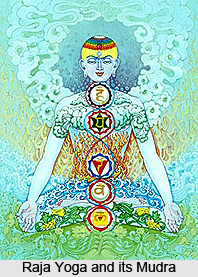 Raja Yoga, also known as the "royal yoga", "royal union", or the Classical Yoga is one of the six orthodox (astika) schools of Hindu philosophy. This yoga was promoted by the widely known sage Patanjali in his book of Yoga Sutras. Raja Yoga is principally concerned with the development of the mind using meditation (dhyana) to extend one`s acquaintance with reality and finally achieve liberation. It is said that the original propounder of Raja Yoga was Hiranyagarbha and it is Patanjali Maharishi who formulated this science into a definite system under the name of Ashtanga Yoga or Raja Yoga. This forms one of the Shad-Darsananas or Classical Systems in Hindu Philosophy.
Raja Yoga, also known as the "royal yoga", "royal union", or the Classical Yoga is one of the six orthodox (astika) schools of Hindu philosophy. This yoga was promoted by the widely known sage Patanjali in his book of Yoga Sutras. Raja Yoga is principally concerned with the development of the mind using meditation (dhyana) to extend one`s acquaintance with reality and finally achieve liberation. It is said that the original propounder of Raja Yoga was Hiranyagarbha and it is Patanjali Maharishi who formulated this science into a definite system under the name of Ashtanga Yoga or Raja Yoga. This forms one of the Shad-Darsananas or Classical Systems in Hindu Philosophy.
The term Raja Yoga is a retronym that was introduced in the 15th-century Hatha Yoga Pradipika to distinguish the school focussing on the Yoga Sutras of Patanjali from the more current school of Hatha Yoga; expounded by Swami Swatmarama. The term was again used later to describe the completely unrelated meditation practice of the Brahma Kumaris that involved the focus of one`s mind and surrender to a channeled entity they believe to be the Supreme Soul. Raja Yoga is also sometimes referred to as Ashtanga (eight-limbed) yoga, because there are eight facets to the path of liberation that should be attended by the Yogi.
Raja Yoga justifies its name because it is primarily concerned with the mind. The mind is traditionally considered as the "king" of the psycho-physical structure which does its bidding (whether or not one has realised this). Owing to the relationship between the mind and the body, the body must be first "tamed" through the task of self-discipline and purified by various means like Hatha Yoga and others. A good level of average health and psychological amalgamation must be attained primarily; before the deeper aspects of yoga are developed. Humans are accustomed to all sorts of addictions and obsessions and these prevent the attainment of tranquil abiding (meditation). Through self-control (yama) such as celibacy, refraining from alcohol and other hard drugs and careful attention to one`s actions of body, speech and mind, the human being makes the individual fit for the practice of Raja Yoga. This yoke that one puts upon oneself (discipline) is another meaning of the word yoga.
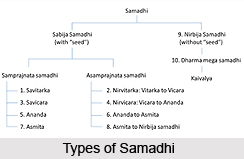
Raja Yoga concerned with the mind, its modifications and its control, states that there are five states of the mind - Kshipta, Mudha, Vikshipta, Ekagra and Niruddha. Usually when the mind is running in different directions and its rays are scattered. This is the Kshipta state. Sometimes it is self-forgetful; it is full of foolishness or the Mudha state. When the person tries to practice concentration, the mind seems to get concentrated but gets distracted quite often; this is Vikshipta state. But with prolonged and repeated practice of concentration again and again, and repeating Lord`s Name, it becomes one-pointed, then it is called the Ekagra state. Later on, when it is fully controlled (Niruddha) it is then ready to be dissolved in the Supreme Purusha. It is then when one attains the Asamprajnata Samadhi.
In Raja Yoga, every thought, feeling, perception, or memory the person may have, causes a particular modification, or ripple, in the mind. It alters and colors the mental mirror and one can restrain the mind from modifying; finally there will be no distortion, and the person will eventually experience the true Self. This is indeed the spontaneous state of quiet mind, known as the "Nirbija" or "seedless state.
The individuals who desire to attain the state of Nirbija should essentially practice Raja Yoga. Thus, Raja Yoga encompasses and distinguishes itself from other forms of Yoga by encouraging the mind to avoid the kind of absorption in obsessed practices, like other customary yogic practices that often create false mental images. In this context, Raja Yoga is widely acclaimed as the "king among yogas". All yogic practices are seen as potential tools for achieving the seedless state and any form of Yoga is considered to be the starting point in the attempt to cleanse Karma and gain Moksha or Nirvana. Historically, schools of yoga that declare themselves as "Raja" offer students a complete blend of yogic practices and this extended philosophical viewpoint.
Eight Limbs Of Ashtanga Yoga
Raja Yoga controls the thought-waves or mental modifications. When a Hatha Yogi starts his Sadhana`, with Asanas (postures) and Pranayama; a Raja Yogi initiates his Sadhana from the mind. However, a certain minimum of asanas and pranayamas are always included as a preparation for the meditation and concentration. In Samadhi Pada I, Pantanjali says that the word of Ishvara is OM or the Pranava. Through the sound of OM and through reflection upon it`s meaning, the divine way is often found. Since Raja Yoga follows the eight ways to reach the final state it is often called the Ashtanga Yoga;
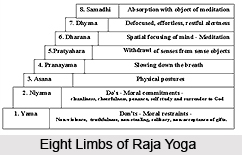 The eight limbs of Ashtanga Yoga are as follows -
The eight limbs of Ashtanga Yoga are as follows -
•Yama - code of conduct or self-restraint
•Niyama - religious observances, commitments to practice, like study and devotion
•Pranayama - regulating the breath that leads to integration of mind and body
•Pratyahara - withdrawal of the senses of perception from their objects
•Asana - assimilation of mind and body through physical activity
•Dharana - concentration or the one - pointedness of mind
•Dhyana - meditation or the quiet activity that leads to the state of samadhi
•Samadhi - the quiet state of heavenly awareness in the super conscious state.
The Ashtanga Yoga is sometimes divided into separate practices for the lower and the upper four limbs. The lower Yogas include steps like yama and pranayama, while the upper yogas include pratyahara and samadhi. The upper three limbs that practise yoga simultaneously constitute the Samyama. The Yama (restraints) consists of five parts, namely Ahimsa (non-violence), Asteya (non-stealing), Satya (truthfulness), Brahmacharya (celibacy), and Aparigraha (non-covetousness). Ahimsa is a perfect state of harmlessness, as well as positive love. The five features of Yama lay down fundamentals like removal of fear, anguish and contribution to a peaceful state of mind. Niyama is observance of five norms, namely Shaucha (internal and external purity), Tapas (austerity), Santosha (contentment), Svadhyaya (study of religious books and repetitions of Mantrams), and Ishvarapranidhana (self-surrender to God, and His worship). Niyama, unlike Yama, directs mental exercises to train the mind how to control emotions. Some say that meditation in Raja Yoga should only be taken up after some specific practices have been mastered. The six prior steps of Patanjali`s Raja Yoga, namely the yama, niyama, asana and so on, can be taken up through the sincere practice of meditation.
Asana play an important role in Raja Yoga, they are postures to develop physical health and flexibility. Asanas, more prominently work to redirect the vital energies and kundalini towards the crown of chakra. Asana are not always `gentle` or comfortable physical exercise, or a `series` of exercises (one particular important asana is standing on your head for hours). Asanas have become a popular way to maintain proper health for the contemporary mass. However, they were not initiated just to `tone muscles` or keep `joints supple`; but were designed to help in the union of the individual self with the divine. If practised properly, asanas can bring kundalini to the crown chakra and help in merging the yogi`s consciousness with the divine consciousness of Shiva.
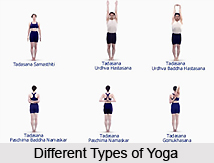 Pranayama is an important feature of Raja Yoga. Pranayama is believed to be the life force or energy control asana. Breathing is the main medium used in achieving this goal. The mind and life force are closely associated with breath. Through regulating the breathing and practicing awareness on it, one learns to control prana. There are many different kinds of pranayama, each with specific goals. All pranayama postures ultimately works towards the awakening of the kundalini shakti at the muladhara chakra. The awakening of kundalini energy and its association with the crown chakra is the final aim of Raja Yoga.
Pranayama is an important feature of Raja Yoga. Pranayama is believed to be the life force or energy control asana. Breathing is the main medium used in achieving this goal. The mind and life force are closely associated with breath. Through regulating the breathing and practicing awareness on it, one learns to control prana. There are many different kinds of pranayama, each with specific goals. All pranayama postures ultimately works towards the awakening of the kundalini shakti at the muladhara chakra. The awakening of kundalini energy and its association with the crown chakra is the final aim of Raja Yoga.
Pratyahara is another vital part of Raja Yoga that brings the awareness to reside deep within oneself, free from the senses of the outside world. The objective of Pratyahara is not to disturb the communication from the sense organ to the brain. The awareness is removed from the five senses. Pratyahara cannot be achieved without the accomplishment of the previous actions like pranayama, niyama and so on. The awareness comes to rest deep in the inner space of mind and during this time the yogi`s breath will be momentarily be suspended. Pratyahara should not be considered merely a stage of concentration or meditation; but it is a yogic practice, which takes on competency in the prior 8 limbs as the fundamental action.
The origin of authentic Yoga is concentration or dharana and Raja Yoga is no exception. Concentration combines into meditation. Meditation ultimately ends in Samadhi. Preservation of breath, Brahmacharya, Satvic (pure) food, silence, seclusion, Satsanga (being in the company of a guru), and not socialising much with people are all related aspects to achieve concentration. Concentrating on Trikuti (the space between the two eyebrows) with closed eyes is the best method of gaining concentration, as mentioned in Raja Yoga. Thence, mind can be easily controlled, as this is considered as the seat for the mind.
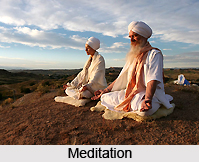
Dhyana is an essential chapter in Raja Yoga, and Hindu philosophy as well. Sleeping, diversion of mind, attachment to objects, laziness, subtle desires and cravings, lack of Brahmacharya, greed are all obstacles in real meditation. One has to reduce his/her desires to attain the success in Raja Yoga. One also has to cultivate dispassion. Vairagya thins out the mind and any actions of regular lifestyle, in excess, are not encouraged. It is always advised to deal with the mind gently during meditation. Any violent efforts at concentration are not encouraged. The best option is to substitute divine thoughts. Regularity in meditation is of paramount importance. Raja Yoga says that the mind passes into many conditions or states as it is made up of three qualities - Sattva, Rajas and Tamas. Kshipta (wandering), Mudha (ignorant), Vikshipta (gathering), Ekagra (one-pointed), and Nirodha (contrary) are the five states of the mind.
Samadhi is the consequence of Sadhana in Raja Yoga. Avidya (ignorance), Raga-Dvesha (likes and dislikes), Asmita (egoism), Abhinivesha (clinging to ordinary life) are the five Kleshas or afflictions. One has to destroy these afflictions to attain Samadhi. Samadhi is of two kinds Savikalpa, Samprajnata or Sabija; and Nirvikalpa, Asamprajnata or Nirbija. In Savikalpa or Sabija, one attains Triputi or the triad (knower, known and knowledge). In Nirvikalpa Samadhi, Nirbija Samadhi or Asamprajnata Samadhi there is no such triad. A Raja Yogi gets Nirodha Samadhi; while Bhakta gets Bhava-Samadhi and a Jnani gets Badha-Samadhi.
In Raja Yoga, the Yogis do not need to believe anything alien, because everything they believe is based on practical experience. The individuals start to perceive for themselves. The practitioners learn many things, but this knowledge is not an end in itself.
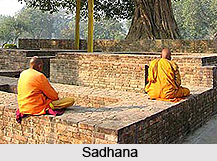 The goal is to find unity with the absolute ultimate Raja Yoga. As this is the goal, the object of meditation must also be the formless and ultimate. Raja Yoga has evolved to be an easy path for the everyday people, who contribute to family life and community, while desiring to attain a spiritual goal. The teachers of Sahaj Marg Raja Yoga state that spiritual growth comes with normalising all functions of an ordinary lifestyle.
The goal is to find unity with the absolute ultimate Raja Yoga. As this is the goal, the object of meditation must also be the formless and ultimate. Raja Yoga has evolved to be an easy path for the everyday people, who contribute to family life and community, while desiring to attain a spiritual goal. The teachers of Sahaj Marg Raja Yoga state that spiritual growth comes with normalising all functions of an ordinary lifestyle.
In Raja Yoga the teacher also helps his students to reveal his/her inner self in various ways. When a yogi gains control over prana, it can be brought to the highest state of vibration and then transmitted to another person, thus arousing in them a similar vibration. They transmit their own spiritual condition to their students as pranahuti (offering of the life force). The higher the teacher`s own spiritual state, the higher the state is from which they transmit and bring about the transformation in the student. It is for this reason that the teacher is so essential in Raja Yoga.
According to Raja Yoga, there are three types of aspirants, namely Uttama, Madhyama and Adhama Adhikaris. To these three classes of aspirants Raja Yoga also prescribes three kinds of Sadhana processes. To the Uttama Adhikari (first-class aspirant) Raja Yoga prescribes Abhyasa and Vairagya. He should practice meditation on the Self and practices Chitta-Vritti-Nirodha (restraining the amendment of the mind) and soon enters into the state of Samadhi.
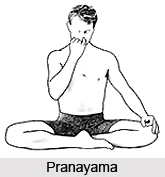 This is practice (Abhyasa) that is sustained by Vairagya. To the Madhyama Adhikari (middling aspirant) Raja Yoga suggests the Kriya Yoga - Tapas, Svadhyaya and Ishvarapranidhana. Tapas means austerity, egoless ness and selfless service are the best forms of Tapas. Disciplinary practices like fasting also come under Tapas. Ishvarapranidhana is self-surrender to the Lord and all actions of Ishvararpana should be performed by the sadhaka. These three forms of Sadhanas if practiced by the Madhyama Adhikari enters into deep meditation eventually attains Kaivalya Moksha. To the Adhama Adhikari, Raja Yoga prescribes Ashtanga Yoga or the eightfold Sadhana - Yama, Niyama, Asana, Pranayama, Pratyahara, Dharana, Dhyana and Samadhi.
This is practice (Abhyasa) that is sustained by Vairagya. To the Madhyama Adhikari (middling aspirant) Raja Yoga suggests the Kriya Yoga - Tapas, Svadhyaya and Ishvarapranidhana. Tapas means austerity, egoless ness and selfless service are the best forms of Tapas. Disciplinary practices like fasting also come under Tapas. Ishvarapranidhana is self-surrender to the Lord and all actions of Ishvararpana should be performed by the sadhaka. These three forms of Sadhanas if practiced by the Madhyama Adhikari enters into deep meditation eventually attains Kaivalya Moksha. To the Adhama Adhikari, Raja Yoga prescribes Ashtanga Yoga or the eightfold Sadhana - Yama, Niyama, Asana, Pranayama, Pratyahara, Dharana, Dhyana and Samadhi.
Raja Yoga takes the student to the highest step of the spiritual ladder of Advaitic realisation of Brahman. Though Raja Yoga is a dualistic philosophy and treats of Prakriti and Purusha together, it helps the student in Advaitic Realisation of oneness eventually. Ultimately the Purusha or the Yogi becomes identical with Highest Self or Purusha, or Brahman of Upanishads in Raja Yoga. Thus, Raja Yoga leads to the cessation of all miseries and attainment of eternal bliss.



